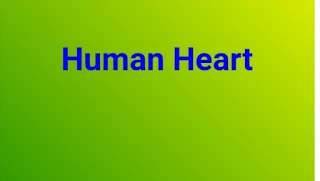Qno. Describe the structure and function of human heart.
Answer:
THE HUMAN HEART
Location : The heart of humans is located in the chest cavity, between two lungs.
SIZE: The size of the heart is almost equal to one's fist.
PROTECTION: The heart is enclosed in a double membranous sac pericardial cavity. Pericardial cavity is a part of body cavity and is between perietal and visceral lining of mesoderm. There is a fluid between these two linings the pericardial fluid. Pericardium protects the heart, prevents its over extension, and helps absorb heat, and reduces friction.
WALL OF HEART: The wall of the heart is composed of three layers.
1). Endocardium
2) Myocardium
3) Epicardium
CARDIAC MUSCLES: Myocardium of the heart is made up of special type of muscles, the cardiac muscles, rather than the smooth muscles of arteries and veins. Both these muscles are involuntary.
Structure of cardiac muscles: The cardiac muscle fibres, contain myofibrils, and myofilaments of myosin and actin. Their arrangement is similar to those in skeletal muscle fibres, and their mechanism of contraction is essentially the same. But they differ in that, it is branching system of cells, a functional but not a cytoplasmic syncitium, in which the successive cells are separated by specialized dual junctions called intercalated discs. The heart contracts automatically within rhythmicity, when interstitial fluids contain chlorides of Na, K and calcium, in precise proportion. The rhythmicity of heart is imposed by autonomic nervous system of the body.
CHAMBERS OF HEART: There are four chambers of the heart.
Two upper thin-walled atria
Two lower thick walled ventricles
Atria receive the blood and pass on to the ventricles, which distribute the blood. The wall of left ventricle is thicker (about 3 time) than that of the right ventricle. Human heart functions as a double pump, and is responsible for pulmonary and systemic circulation.
There is complete separation of deoxygenated blood (Right side) and oxygenated blood (left side), in the heart, is maintained.
Blood pathway in the heart
Right atrium: The right atrium receives deoxygenated blood via vena cava from the body.
Right ventricle: The blood is passed on to right ventricle through tricuspid valve (because it has 3 flaps). These flaps are attached with fibrous cords called chordeae tendinae.
Pulmonary artery: When right ventricle contracts, the blood passes to pulmonary artery, which carry blood to the lungs. At the base of the pulmonary artery, semilunar valves are present.
Pulmonary vein: After oxygenation the blood is brought by pulmonary veins to the left auricle.
Left auricle: Left auricle passes this blood via bicuspid valve (because it has two flaps) to the left ventricle. The flaps of bicuspid valve are similarly attached through chordae tendinae.
Left ventricle: When the left ventricle contracts, it pushes the blood through aorta to all parts of the body (except lungs). At the base of aorta semilunar valves are also present.
Function of valves: The valves of the heart control the direction of flow of blood.
Coronary arteries: At the base of aorta,first pair of arteries, the coronary arteries arises and supply blood to the heart.
Qno. Describe the cardiae cycle in detail. Answer:
The Cardiac Cycle: It is the sequence of events, which take place during the completion of one heartbeat. Heartbeat involves three distinct stages.
1)Relaxation Phase diastole.The deoxygenated blood enters right atrium through vena cava, and oxygenated blood enters left atrium through pulmonary veins. The walls of the atria and that of ventricles are relaxed. As the atria are filled with blood, they become distended and have more pressure than the ventricles. This relaxed period of heart chambers is called diastole.
2) Atria Contract atrial systole. The muscles of atria, when they are filled and distended with blood, simultancously contract. The blood passes through tricuspid and bicuspid valves, into the two ventricles which are relaxed.
3) Ventricles contract ventricular systole: When the ventricles receive blood from atria, both ventricles contract simultaneously and the blood is pumped to pulmonary artery and aorta. The tricuspid and bicuspid valves close, and bulb sound is made. Ventricular systole ends, and ventricles relax at the same time semilunar valves at the base of pulmonary artery and aorta close simultaneously, and 'dubb' sound is made. (Lubb, dubb can be heard with the help of stethoscope). One complete heart beat consists of one systole and one diastole, and lasts for about 0.8 seconds. In one's life heart contracts about 2.5 billion times, without stopping.
a. Mechanism of heart excitation and contraction
Answer:
The heart beat cycle starts when the sino-atrial node (Pace maker) at the upper end of right atrium sends out electrical impulses to the atrial muscles, and causing both atria to contract. The sino-atrial node is a vestige of the sinus venosus seen in the heart of lower vertebrates, close to the point of entry of the vena cava. It consists of a small number of diffusely oriented cardiac fibres, possessing few myofibrils; and few nerve endings from the autonomic nervous system. Impulses from the node are propagated by the special electro conductive muscle cells to the musculature of the atrium and to an atrioventricular node. The atrial muscle fibres are completely separated from those of the ventricles by atrioventricular septum of connective tissue, except for the region in the right atrium called atrioventricular node (A-V node). From atrioventricular node, an atrioventricular bundle of muscle fibres propagate the regulatory impulses via the interventricular septum to the myocardium of the ventricles. There is a delay of approximately 0.15 second in conductance from the S-A node to A-V node, thus permitting fatrial systole to be completed before ventricular systole begins. The heart's electrical activity during heart beat can be studied by E.C.G. machine i.e. Electrocardiogram machine.




0 Comments